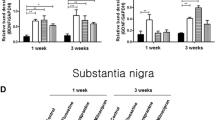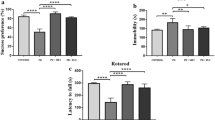Abstract
Depression is a common non-motor symptom in patients with Parkinson’s disease (PD) and difficult to treat. Crocin is a natural multipotential neuroprotective compound that has been shown to elicit antidepressant activity and is promising for the therapy of neuropsychological diseases. Here, we investigated the therapeutic effect of crocin in a mouse model of Parkinson’s disease depression (PDD) and clarified the underlying mechanism. We prepared 1-methyl-4-phenyl-1,2,3,6-tetrahydropyridine (MPTP)-induced subacute mouse model of PD, and found that around 60% of the model mice showed depression-like behavior, using the forced swimming test (FST). A regime of 10-day treatment of crocin alleviated the PDD symptoms. The crocin reduced the structural damage in soma volume and axon length of neurons and inhibited their spontaneous discharge in dopaminergic (DA) neurons in the ventral tegmental area (VTA). Notably, the MPTP-treated mice showed the decrease in the critical signaling for synaptic plasticity, including the proteins of PSD-95, synapsin-1, and GluR-1, in the medial prefrontal cortex (mPFC) where it receives efferent from VTA and regulates depression-like behavior. However, crocin treatment rescued the defect of the mammalian target of rapamycin (mTOR) signaling in PDD mice. Furthermore, the antidepressant action of crocin was blunted after blockade of mTOR signaling with the antagonist rapamycin. In conclusion, our study demonstrated that crocin protected the DA projection neurons in the VTA through activating mTOR, which subsequently improved the neural synaptic plasticity of mPFC, and ameliorated depression-like behavior in PD mice.





Similar content being viewed by others
References
Chaudhuri KR, Healy DG, Schapira AH, National Institute for Clinical E (2006) Non-motor symptoms of Parkinson's disease: diagnosis and management. Lancet Neurol 5(3):235–245. https://doi.org/10.1016/S1474-4422(06)70373-8
Gustafsson H, Nordstrom A, Nordstrom P (2015) Depression and subsequent risk of Parkinson disease: a nationwide cohort study. Neurology 84(24):2422–2429. https://doi.org/10.1212/WNL.0000000000001684
Reijnders JS, Ehrt U, Weber WE, Aarsland D, Leentjens AF (2008) A systematic review of prevalence studies of depression in Parkinson’s disease. Mov Disord 23(2):183–189; quiz 313. https://doi.org/10.1002/mds.21803
Wei L, Hu X, Yuan Y, Liu W, Chen H (2018) Abnormal ventral tegmental area-anterior cingulate cortex connectivity in Parkinson’s disease with depression. Behav Brain Res 347:132–139. https://doi.org/10.1016/j.bbr.2018.03.011
Riga D, Matos MR, Glas A, Smit AB, Spijker S, Van den Oever MC (2014) Optogenetic dissection of medial prefrontal cortex circuitry. Front Syst Neurosci 8:230. https://doi.org/10.3389/fnsys.2014.00230
Gerhard DM, Duman RS (2018) Rapid-acting antidepressants: mechanistic insights and future directions. Curr Behav Neurosci Rep 5(1):36–47
Xie Y, He Q, Chen H, Lin Z, Xu Y, Yang C (2019) Crocin ameliorates chronic obstructive pulmonary disease-induced depression via PI3K/Akt mediated suppression of inflammation. Eur J Pharmacol 862:172640. https://doi.org/10.1016/j.ejphar.2019.172640
Zhang L, Previn R, Lu L, Liao RF, Jin Y, Wang RK (2018) Crocin, a natural product attenuates lipopolysaccharide-induced anxiety and depressive-like behaviors through suppressing NF-kB and NLRP3 signaling pathway. Brain Res Bull 142:352–359. https://doi.org/10.1016/j.brainresbull.2018.08.021
Ghalandari-Shamami M, Nourizade S, Yousefi B, Vafaei AA, Pakdel R, Rashidy-Pour A (2019) Beneficial effects of physical activity and Crocin against adolescent stress induced anxiety or depressive-like symptoms and dendritic morphology remodeling in prefrontal cortex in adult male rats. Neurochem Res 44(4):917–929. https://doi.org/10.1007/s11064-019-02727-2
Rao SV, Muralidhara, Yenisetti SC, Rajini PS (2016) Evidence of neuroprotective effects of saffron and crocin in a Drosophila model of parkinsonism. Neurotoxicology 52:230–242. https://doi.org/10.1016/j.neuro.2015.12.010
Rajaei Z, Hosseini M, Alaei H (2016) Effects of crocin on brain oxidative damage and aversive memory in a 6-OHDA model of Parkinson’s disease. Arq Neuropsiquiatr 74(9):723–729. https://doi.org/10.1590/0004-282X20160131
Wu R, Tao W, Zhang H, Xue W, Zou Z, Wu H, Cai B, Doron R et al (2016) Instant and persistent antidepressant response of Gardenia yellow pigment is associated with acute protein synthesis and delayed upregulation of BDNF expression in the hippocampus. ACS Chem Neurosci 7(8):1068–1076. https://doi.org/10.1021/acschemneuro.6b00011
Pfister S, Meyer P, Steck A, Pfander H (1996) Isolation and structure elucidation of carotenoid−glycosyl esters in gardenia fruits (gardenia jasminoides ellis) and saffron (crocus sativus linne). J Agric Food Chem 44(9):2612–2615
Zhang X, Song D, Gu L, Ren Y, Verkhratsky A, Peng L (2015) Decrease of gene expression of astrocytic 5-HT2B receptors parallels development of depressive phenotype in a mouse model of Parkinson’s disease. Front Cell Neurosci 9:388. https://doi.org/10.3389/fncel.2015.00388
Wu R, Xiao D, Shan X, Dong Y, Tao WW (2020) Rapid and prolonged antidepressant-like effect of crocin is associated with GHSR-mediated hippocampal plasticity-related proteins in mice exposed to prenatal stress. ACS Chem Neurosci 11(8):1159–1170. https://doi.org/10.1021/acschemneuro.0c00022
Tang J, Xue W, Xia B, Ren L, Tao W, Chen C, Zhang H, Wu R et al (2015) Involvement of normalized NMDA receptor and mTOR-related signaling in rapid antidepressant effects of Yueju and ketamine on chronically stressed mice. Sci Rep 5:13573. https://doi.org/10.1038/srep13573
Lu M, Zhao FF, Tang JJ, Su CJ, Fan Y, Ding JH, Bian JS, Hu G (2012) The neuroprotection of hydrogen sulfide against MPTP-induced dopaminergic neuron degeneration involves uncoupling protein 2 rather than ATP-sensitive potassium channels. Antioxid Redox Signal 17(6):849–859. https://doi.org/10.1089/ars.2011.4507
Zhang Y, Du L, Bai Y, Han B, He C, Gong L, Huang R, Shen L et al (2018) CircDYM ameliorates depressive-like behavior by targeting miR-9 to regulate microglial activation via HSP90 ubiquitination. Mol Psychiatry. https://doi.org/10.1038/s41380-018-0285-0
Chen C, Xia B, Tang L, Wu W, Tang J, Liang Y, Yang H, Zhang Z et al (2019) Echinacoside protects against MPTP/MPP(+)-induced neurotoxicity via regulating autophagy pathway mediated by Sirt1. Metab Brain Dis 34(1):203–212. https://doi.org/10.1007/s11011-018-0330-3
Cooney JW, Stacy M (2016) Neuropsychiatric issues in Parkinson’s disease. Curr Neurol Neurosci Rep 16(5):49. https://doi.org/10.1007/s11910-016-0647-4
Kulisevsky J, Oliveira L, Fox SH (2018) Update in therapeutic strategies for Parkinson’s disease. Curr Opin Neurol 31(4):439–447. https://doi.org/10.1097/WCO.0000000000000579
Okano M, Takahata K, Sugimoto J, Muraoka S (2019) Selegiline recovers synaptic plasticity in the medial prefrontal cortex and improves corresponding depression-like behavior in a mouse model of Parkinson’s disease. Front Behav Neurosci 13:176. https://doi.org/10.3389/fnbeh.2019.00176
Sampaio TB, Marcondes Sari MH, Pesarico AP, Mantovani AC, Zeni G, Nogueira CW (2018) 7-Fluoro-1,3-diphenylisoquinoline reverses motor and non-motor symptoms induced by MPTP in mice: role of striatal neuroinflammation. Eur J Pharmacol 819:129–135. https://doi.org/10.1016/j.ejphar.2017.12.001
Schamne MG, Mack JM, Moretti M, Matheus FC, Walz R, Lanfumey L, Prediger RD (2018) The gender-biased effects of intranasal MPTP administration on anhedonic- and depressive-like behaviors in C57BL/6 mice: the role of neurotrophic factors. Neurotox Res 34(4):808–819. https://doi.org/10.1007/s12640-018-9912-4
Dalle E, Mabandla MV (2018) Early life stress, depression and Parkinson’s disease: a new approach. Mol Brain 11(1):18. https://doi.org/10.1186/s13041-018-0356-9
Yan T, Sun Y, Gong G, Li Y, Fan K, Wu B, Bi K, Jia Y (2019) The neuroprotective effect of schisandrol A on 6-OHDA-induced PD mice may be related to PI3K/AKT and IKK/IkappaBalpha/NF-kappaB pathway. Exp Gerontol 128:110743. https://doi.org/10.1016/j.exger.2019.110743
Przedborski S (2017) The two-century journey of Parkinson disease research. Nat Rev Neurosci 18(4):251–259. https://doi.org/10.1038/nrn.2017.25
Surmeier DJ, Obeso JA, Halliday GM (2017) Selective neuronal vulnerability in Parkinson disease. Nat Rev Neurosci 18(2):101–113. https://doi.org/10.1038/nrn.2016.178
Xin W, Edwards N, Bonci A (2016) VTA dopamine neuron plasticity—the unusual suspects. Eur J Neurosci 44(12):2975–2983. https://doi.org/10.1111/ejn.13425
Friedman AK, Walsh JJ, Juarez B, Ku SM, Chaudhury D, Wang J, Li X, Dietz DM et al (2014) Enhancing depression mechanisms in midbrain dopamine neurons achieves homeostatic resilience. Science 344(6181):313–319. https://doi.org/10.1126/science.1249240
Aarsland D, Pahlhagen S, Ballard CG, Ehrt U, Svenningsson P (2011) Depression in Parkinson disease—epidemiology, mechanisms and management. Nat Rev Neurol 8(1):35–47. https://doi.org/10.1038/nrneurol.2011.189
Nair-Roberts RG, Chatelain-Badie SD, Benson E, White-Cooper H, Bolam JP, Ungless MA (2008) Stereological estimates of dopaminergic, GABAergic and glutamatergic neurons in the ventral tegmental area, substantia nigra and retrorubral field in the rat. Neuroscience 152(4):1024–1031. https://doi.org/10.1016/j.neuroscience.2008.01.046
Robbins TW, Arnsten AF (2009) The neuropsychopharmacology of fronto-executive function: monoaminergic modulation. Annu Rev Neurosci 32:267–287. https://doi.org/10.1146/annurev.neuro.051508.135535
Tye KM, Mirzabekov JJ, Warden MR, Ferenczi EA, Tsai HC, Finkelstein J, Kim SY, Adhikari A et al (2013) Dopamine neurons modulate neural encoding and expression of depression-related behaviour. Nature 493(7433):537–541. https://doi.org/10.1038/nature11740
Li L, Sun H, Ding J, Niu C, Su M, Zhang L, Li Y, Wang C et al (2017) Selective targeting of M-type potassium Kv 7.4 channels demonstrates their key role in the regulation of dopaminergic neuronal excitability and depression-like behaviour. Br J Pharmacol 174(23):4277–4294. https://doi.org/10.1111/bph.14026
Farassat N, Costa KM, Stojanovic S, Albert S, Kovacheva L, Shin J, Egger R, Somayaji M et al (2019) In vivo functional diversity of midbrain dopamine neurons within identified axonal projections. Elife 8:8. https://doi.org/10.7554/eLife.48408
Bockaert J, Marin P (2015) mTOR in brain physiology and pathologies. Physiol Rev 95(4):1157–1187. https://doi.org/10.1152/physrev.00038.2014
Fernandez-Santiago R, Martin-Flores N, Antonelli F, Cerquera C, Moreno V, Bandres-Ciga S, Manduchi E, Tolosa E et al (2019) SNCA and mTOR pathway single nucleotide polymorphisms interact to modulate the age at onset of Parkinson’s disease. Mov Disord 34(9):1333–1344. https://doi.org/10.1002/mds.27770
Tain LS, Mortiboys H, Tao RN, Ziviani E, Bandmann O, Whitworth AJ (2009) Rapamycin activation of 4E-BP prevents parkinsonian dopaminergic neuron loss. Nat Neurosci 12(9):1129–1135. https://doi.org/10.1038/nn.2372
Li N, Lee B, Liu RJ, Banasr M, Dwyer JM, Iwata M, Li XY, Aghajanian G et al (2010) mTOR-dependent synapse formation underlies the rapid antidepressant effects of NMDA antagonists. Science 329(5994):959–964. https://doi.org/10.1126/science.1190287
Cleary C, Linde JA, Hiscock KM, Hadas I, Belmaker RH, Agam G, Flaisher-Grinberg S, Einat H (2008) Antidepressive-like effects of rapamycin in animal models: implications for mTOR inhibition as a new target for treatment of affective disorders. Brain Res Bull 76(5):469–473. https://doi.org/10.1016/j.brainresbull.2008.03.005
Beier KT, Steinberg EE, DeLoach KE, Xie S, Miyamichi K, Schwarz L, Gao XJ, Kremer EJ et al (2015) Circuit architecture of VTA dopamine neurons revealed by systematic input-output mapping. Cell 162(3):622–634. https://doi.org/10.1016/j.cell.2015.07.015
Funding
This work was supported by the National Natural Science Foundation of China (no.81603089, no. 81873096) and the Natural Science Foundation of Jiangsu Province (BK20161044).
Author information
Authors and Affiliations
Contributions
Special thanks to all authors who contributed to this research. Juanjuan Tang and Gang Chen designed the whole study together. Linyu Lu provided all pictures in the manuscript. Qisheng Wang, Kai Wang, and Die Wu prepared the animal model. Hou Liu and Tong Zhou took responsibility for the data of patch clamp. Wenda Xue guided the statistics of the manuscript. Weiwei Tao and Liantiao Xu took responsible for preparation and identification of β-D-gentiobiosyl crocetin. Juanjuan Tang wrote the whole paper and organized all supplemental information materials. Gang Chen and Fei Wei provided corrections for the paper.
Corresponding author
Ethics declarations
Conflict of Interest
The authors declare that they have no conflict of interest.
Additional information
Publisher’s Note
Springer Nature remains neutral with regard to jurisdictional claims in published maps and institutional affiliations.
Rights and permissions
About this article
Cite this article
Tang, J., Lu, L., Wang, Q. et al. Crocin Reverses Depression-Like Behavior in Parkinson Disease Mice via VTA-mPFC Pathway. Mol Neurobiol 57, 3158–3170 (2020). https://doi.org/10.1007/s12035-020-01941-2
Received:
Accepted:
Published:
Issue Date:
DOI: https://doi.org/10.1007/s12035-020-01941-2




